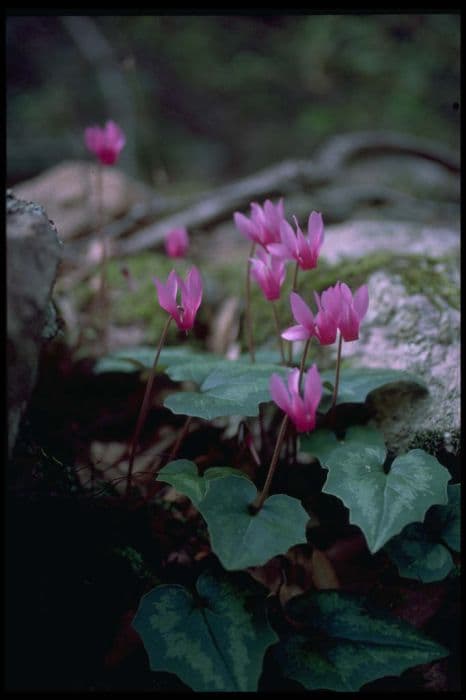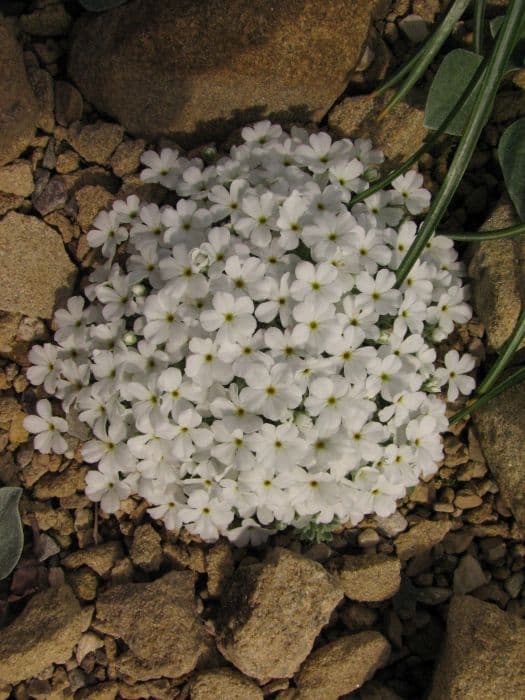Spring Sowbread Cyclamen repandum

ABOUT
Cyclamen repandum, commonly known as ivy-leaved cyclamen, is a perennial plant known for its decorative foliage and attractive flowers. The leaves are heart or ivy-shaped with a marbled pattern of dark green and silver, providing a striking contrast that makes the foliage as ornamental as the flowers. They typically emerge in the fall and last until spring. The flowers of this ivy-leaved cyclamen are delicate and nodding, with upswept petals that are often compared to butterfly wings. The blooms boast a variety of colors, ranging from white to pink and occasionally showing deeper shades at the base. This feature gives the flowers a two-tone appearance that adds to their charm. Adding to its appeal, the ivy-leaved cyclamen produces a pleasant fragrance, making it a favorite among scented garden plants. The contrast between the beautifully patterned leaves and the elegant flowers creates a stunning visual impact in woodland gardens, shaded borders, or when grown as an indoor houseplant. Despite its delicate appearance, ivy-leaved cyclamen is a hardy plant capable of withstanding cold winter temperatures in some climates.
About this plant
 Names
NamesFamily
Primulaceae
Synonyms
Spring Sowbread, Ivy-Leaved Cyclamen, Eastern Sowbread
Common names
Cyclamen vernale, Cyclamen repandum subsp. peloponnesiacum, Cyclamen rhodium subsp. vividum, Cyclamen rhodium subsp. peloponnesiacum, Cyclamen elegans, Cyclamen peloponnesiacum, Cyclamen cyprium, Cyclamen graecum, Cyclamen libanoticum, Cyclamen cilicium.
 Toxicity
ToxicityTo humans
The plant commonly known as ivy-leaved cyclamen, Cyclamen repandum, contains saponins, which can cause toxicity when ingested by humans. If any part of the ivy-leaved cyclamen is eaten, it can lead to gastrointestinal symptoms such as nausea, vomiting, and diarrhea. In some cases, ingesting the plant can also result in muscle tremors, seizures, and heart rhythm abnormalities. Contact with the skin can sometimes cause dermatitis.
To pets
Ivy-leaved cyclamen is also toxic to pets due to the presence of saponins. If a pet such as a dog or cat ingests any part of the plant, they may exhibit symptoms like vomiting, diarrhea, and salivation. In severe cases, ingestion can lead to heart rhythm abnormalities, seizures, and even death. Prompt veterinary care is recommended if a pet consumes ivy-leaved cyclamen.
 Characteristics
CharacteristicsLife cycle
Perennials
Foliage type
Evergreen
Color of leaves
Green
Flower color
Pink
Height
6 inches (15 cm)
Spread
6 inches (15 cm)
Plant type
Bulb
Hardiness zones
9
Native area
Mediterranean
Benefits
 General Benefits
General Benefits- Ornamental Value: Cyclamen repandum is renowned for its attractive flowers and foliage, adding beauty to gardens and homes.
- Seasonal Interest: It blooms during spring, adding seasonal color and interest to shady garden areas or woodland settings.
- Drought Tolerance: Once established, it is fairly tolerant of dry conditions, making it suitable for xeriscaping.
- Shade Lover: It thrives in shaded areas, providing options for landscapers to plant vibrant flowers where sunlight is limited.
- Ground Cover: Its spreading habit makes it an excellent ground cover, reducing soil erosion and suppressing weeds.
- Low Maintenance: Cyclamen repandum generally requires minimal care once it has adapted to its location, making it a convenient choice for gardeners.
- Pollinator Attraction: The flowers attract pollinators such as bees, supporting the ecosystem.
- Long-Life Cycle: It is a perennial plant, meaning it can live for several years, giving long-term enjoyment.
- Winter Interest: In some varieties, foliage can persist through mild winters, providing greenery year-round.
- Non-Invasiveness: Cyclamen repandum is not known to be invasive and tends to grow within its bounds.
 Medical Properties
Medical Properties- This plant is not used for medical purposes.
 Air-purifying Qualities
Air-purifying QualitiesThis plant is not specifically known for air purifying qualities.
 Other Uses
Other Uses- Cyclamen repandum, commonly known as spring cyclamen, can be used in educational workshops to teach about pollination, as it has a unique mechanism where its flowers reflex when they are ready for it.
- The tubers of spring cyclamen are rich in starch and have been historically used in some cultures as a food source after proper preparation to remove toxicity.
- The petals of spring cyclamen can be used in the art of flower pressing due to their distinct shape and vibrant colors, making them ideal for botanical art and crafts.
- Florists may use dried spring cyclamen flowers in the creation of sustainable, biodegradable confetti for events such as weddings.
- Spring cyclamen is often used in fairy gardens due to its delicate appearance and ability to thrive in shady environments, thereby enhancing the mystical appeal of these miniature landscapes.
- Gardeners can utilize the distinctive leaves of spring cyclamen in mosaic patterns within shade gardens, taking advantage of their variegation and heart-shaped form.
- Leaves of the spring cyclamen can be used in nature-inspired art installations, particularly because of their interesting mottled patterns that can enhance visual texture.
- Spring cyclamen's flowers can serve as natural dyes in crafting and fabric staining, although this is not a common practice.
- Photographers may use spring cyclamen as a subject in macro photography workshops to illustrate depth of field and color saturation techniques.
- Spring cyclamen can be used in designing intricate topiaries and garden mosaics when planted in mass, forming patterns with its colorful blooms and foliage.
Interesting Facts
 Feng Shui
Feng ShuiThe Cyclamen is not used in Feng Shui practice.
 Zodiac Sign Compitability
Zodiac Sign CompitabilityThe Cyclamen is not used in astrology practice.
 Plant Symbolism
Plant Symbolism- Devotion & Sincerity: Cyclamen, commonly referred to as Persian Violet, often symbolizes devoted love and sincere affection due its heart-shaped leaves, which resemble love and tenderness in relationships.
- Goodbye & Parting: In the language of flowers, giving a cyclamen plant can imply a parting, resignation, or a quiet goodbye, possibly indicating a desire for a break or the end of a relationship.
- Resilience & Survival: The plant's ability to go dormant and re-emerge with vitality during the right season is symbolic of resilience and the ability to survive difficult situations or periods of dormancy in life.
- Femininity & Motherly Love: The delicate yet robust nature of the Persian Violet mirrors traditional symbols of femininity, and it is at times given as a gift to represent protective, motherly care.
 Water
WaterThe Spring Cyclamen requires moderate watering during active growth, which typically involves providing water when the top inch of soil feels dry. Generally, this may mean watering with about 1 to 2 gallons per week depending on the pot size and environmental conditions. During dormancy, after the leaves yellow, reduce watering significantly to prevent bulb rot. Always water gently around the plant to moisten the soil evenly without soaking. Avoid wetting the foliage or center of the plant as it can lead to fungal diseases.
 Light
LightThe Spring Cyclamen prefers bright, indirect light. It thrives best when placed in a north or east-facing window that receives some morning light or filtered sunlight throughout the day. Direct afternoon sunlight should be avoided as it can scorch the leaves of the plant.
 Temperature
TemperatureThe Spring Cyclamen enjoys cooler temperatures and will thrive in a range between 50–68 degrees Fahrenheit. It can tolerate a short-term minimum of around 40 degrees Fahrenheit and should not be exposed to temperatures above 77 degrees Fahrenheit for sustainable health and flowering. Ideal conditions mimic its native habitat in the Mediterranean with cool and well-ventilated environments.
 Pruning
PruningPruning Spring Cyclamen involves removing yellow or dead leaves and spent flowers to promote healthy growth and prevent disease. Prune after flowering, typically cutting back the foliage once it starts to yellow and wither, which generally happens as the plant enters dormancy. Pruning once a year at this stage helps maintain a tidy appearance and encourages a robust bloom in the next growing season.
 Cleaning
CleaningAs needed
 Soil
SoilSpring blooming Cyclamen requires well-draining soil with high organic content, such as a mix of peat, perlite, and garden soil. Aim for a slightly acidic to neutral pH of 6.5 to 7.5.
 Repotting
RepottingSpring blooming Cyclamen should be repotted every couple of years or once their tubers fill the pot, typically after their dormant phase in the summer.
 Humidity & Misting
Humidity & MistingSpring blooming Cyclamen thrive at moderate to high humidity levels, around 50-70%, avoiding excessively dry air which can cause bud drop and leaf edge burn.
 Suitable locations
Suitable locationsIndoor
Grow Cyclamen in bright, indirect light, with cool temperatures and high humidity.
Outdoor
Place Spring blooming Cyclamen in dappled shade, sheltered from intense midday sun.
Hardiness zone
7-9 USDA
 Life cycle
Life cycleCyclamen repandum, commonly known as Eastern cyclamen or spring cyclamen, begins its life cycle as a seed, which germinates in cooler, moist conditions to develop a tuberous rootstock. The plant enters a growth stage where heart-shaped, patterned leaves emerge from the tuber in a basal rosette and grow throughout autumn, winter, and early spring. During the spring, delicate flowers with reflexed petals that vary in color from white to pink with a magenta blotch at the base, bloom above the foliage. After pollination, typically by insects, the flower stems coil and bring the developing seed pods closer to the ground. Once the seeds are ripe, they are dispersed, often by ants attracted to their fatty appendages. The plant then enters a dormancy phase during the hot and dry summer months, with the leaves withering away, and the cycle repeats when cooler weather resumes.
 Propogation
PropogationPropogation time
Spring to Summer
Propogation: Cyclamen repandum, commonly known as the spring cyclamen, is typically propagated through seed. The best time to sow cyclamen seeds is in the late summer or early fall. Fresh seeds are sown on the surface of a well-draining soil mix and only lightly covered with soil or vermiculite. The pot containing seeds should be kept in a cool place, around 50 to 65 degrees Fahrenheit (10 to 18 degrees Celsius), and the soil should be kept moist but not waterlogged. Germination is often slow and may take several weeks to months. Once the seedlings emerge, they can be gradually acclimated to brighter light conditions, but still, avoid direct sunlight. When seedlings have developed a few true leaves, they can be carefully transplanted into individual pots to grow on.







![Primrose [Belarina Amethyst Ice]](/_next/image?url=https%3A%2F%2Fplants-admin.emdemapps.com%2Fimages%2Fplants%2F%2Fimages%2F604b59c727782.png&w=640&q=75)

